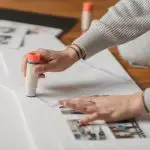When you're tackling no-sew projects, fabric tape can be a game changer. It offers a straightforward way to secure hems and seams without the hassle of a needle and thread. You'll find that its strong adhesive works on various fabric types, allowing for quick fixes or elaborate designs. But how do you choose the right tape for your specific project? And what are some creative ways to maximize its potential? Exploring these aspects might just transform your approach to crafting.
Table of Contents
Key Takeaways
- Fabric tape provides a quick, no-sew solution for various projects, saving time and effort in crafting and repairs.
- It offers a strong bond for securing hems, seams, and appliqués, ensuring durability and longevity in fabric items.
- Fabric tape is versatile, suitable for different materials such as cotton and denim, accommodating diverse crafting needs.
- It is user-friendly, making it accessible for beginners to create custom items without sewing skills.
Benefits of Fabric Tape
Fabric tape offers a quick and easy solution for your no-sew projects, saving you time and hassle. One of the biggest benefits is its versatility. You can use it on a variety of fabrics, from cotton to denim, making it perfect for any project you have in mind. You won't need to worry about matching thread colors or using a sewing machine.
Another advantage is the strong bond it creates. Once applied, the tape holds securely, ensuring your hems, seams, or appliqués stay in place. This durability means you can trust your projects to withstand wear, so you can enjoy your creations without constant repairs.
Additionally, fabric tape is incredibly user-friendly. You can cut it to the desired length and apply it easily, even if you're a beginner. It's a fantastic option for last-minute repairs or quick alterations.
Common No-Sew Applications
Finding creative ways to use fabric tape can transform your crafting experience into a seamless journey, making it ideal for various no-sew applications.
One popular use is in hem adjustments. Instead of sewing, simply fold the hem, apply the tape, and press to secure. You'll achieve a polished look without the hassle of needle and thread.
Another great application is creating quick and easy fabric banners. Just cut your fabric into desired shapes, attach them to a string using fabric tape, and you've got a stunning decoration for any occasion.
You can also use fabric tape to make pillow covers or cushion cases. Fold the fabric edges inward, tape them down, and you've got a custom cover in minutes.
If you're feeling adventurous, why not try making a fabric bag? Fold the fabric, tape the sides, and add a handle. You can even personalize it with additional fabric tape designs.
Lastly, fabric tape comes in handy for repairing torn clothing or securing frayed edges. With these applications, you'll find that fabric tape not only saves time but also opens up a world of creative possibilities in your no-sew projects.
Choosing the Right Fabric Tape
When selecting the right fabric tape for your no-sew projects, consider factors like adhesive strength and fabric compatibility to ensure optimal results.
First, think about the type of fabric you're working with. Some tapes are designed for lightweight materials, while others work best with heavier fabrics. Check the product specifications to find a tape that matches your fabric type.
Next, evaluate the adhesive strength. If you're crafting items that will experience frequent movement or stress, choose a tape with stronger adhesive properties. For projects requiring flexibility, look for tapes that allow some stretch without losing adhesion.
You should also pay attention to the width of the tape. Wider tapes provide more surface area for bonding, which can be beneficial for larger seams or hems. However, if you're working on detailed projects or seams that require precision, narrower tape might be the better option.
Lastly, consider whether you need a washable tape. If your project will be exposed to water or frequent washing, opt for tape specifically designed to withstand those conditions.
Tips for Effective Use
To achieve the best results with fabric tape, make sure to clean the fabric surface thoroughly before applying the tape. Dirt, dust, or oil can weaken the adhesive and compromise your project's integrity. After cleaning, ensure your fabric is dry and smooth. This helps the tape stick better.
When applying the tape, press it firmly onto the fabric and hold it in place for a few seconds to secure the bond. For better adhesion, consider using a roller or brayer to apply even pressure. If you're working with intricate designs, cut the tape into manageable strips rather than using long pieces, which can be unwieldy.
Always test the tape on a small fabric swatch first to ensure it adheres properly and doesn't damage the fabric. If you're layering tape, overlap the edges slightly for a stronger hold. Additionally, avoid stretching the tape while applying it, as this can lead to uneven results.
Lastly, remember that fabric tape works best on fabrics that don't experience a lot of stress. For high-stress areas, consider reinforcing with stitches or additional tape for durability. Following these tips will help you maximize the effectiveness of your fabric tape projects.
Creative Project Ideas
Now that you've mastered tips for effective use, let's explore some creative project ideas that showcase the versatility of fabric tape.
One fun project is creating custom bookmarks. Simply cut strips of fabric tape in your favorite colors, layer them, and trim them to your desired shape. You'll have unique bookmarks that stand out!
Another idea is to design decorative wall art. Use fabric tape to create geometric patterns on a canvas or directly on your wall. This technique adds a pop of color and texture without the mess of paint.
You can also personalize your phone case. Take a plain case and apply fabric tape in various patterns or colors to give it a fresh, new look.
If you're looking for something functional, consider making fabric tape coasters. Cut circles from cork or cardboard, then cover them with fabric tape for a stylish and protective surface for your drinks.
Lastly, try upcycling old furniture. Use fabric tape to add stripes or borders on drawer fronts or table edges, giving new life to tired pieces.
With these ideas, you'll see just how creative you can get with fabric tape!
Frequently Asked Questions
Is Fabric Tape Washable After Application?
Yes, fabric tape is generally washable after application, but it's best to check the manufacturer's instructions. You'll want to ensure it's properly adhered and suitable for the specific fabric you're using.
Can Fabric Tape Be Used on Delicate Fabrics?
Yes, you can use fabric tape on delicate fabrics. Just be gentle when applying it, as excessive pressure might damage the material. Test a small area first to ensure it adheres well without causing harm.
How Long Does Fabric Tape Last Once Applied?
Fabric tape typically lasts for several weeks to a few months, depending on the fabric type and conditions. If you keep it dry and avoid heavy stress, it'll hold up longer than expected.
Is Fabric Tape Safe for Children's Clothing?
Yes, fabric tape is generally safe for children's clothing. Just ensure it's non-toxic and suitable for fabric use. Always check product labels and test on a small area to avoid any skin irritation.
Can Fabric Tape Withstand High Temperatures?
Fabric tape typically can't withstand high temperatures, as heat often weakens the adhesive. If you're working on projects that involve heat, it's best to explore alternatives designed for high-temperature applications to ensure durability.
- The Use of Nonwovens in Construction and Civil Engineering - July 11, 2025
- The Use of Nonwovens in Construction and Civil Engineering - July 11, 2025
- The Use of Nonwovens in Construction and Civil Engineering - July 11, 2025







